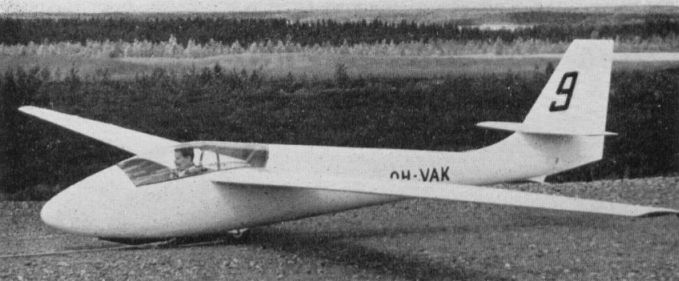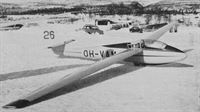
M.Hardy. Gliders & Sailplanes of the world
PIK-16C Vasama
The PIK-16C Vasama (or Arrow) single-seat Standard Class sailplane was designed by Tuomo Tervo, Jorma Jalkanen and Kurt Hedstrom, who made use of design experience with the earlier PIK-3C Kajava. The prototype first flew on 1 June 1961 and had a 'butterfly' V-tail; the PIK-16A and PIK-16B were followed by the major production version the PIK-16C, which has a conventional tail unit instead of the earlier V-tail, and several other improvements, such as a sandwich-type construction for the wing leading edge. In 1963 the PIK-16C was awarded the OSTIV prize for the best Standard Class sailplane, and at that year's World Gliding Championships held at Junin, Argentina, a PIK-16C was flown into third place in the Standard Class by Juhani Horma of Finland; the type also set up several Finnish records. The PIK-16C was put into production by K. K. Lehtovaara O/Y of Hameenlinna and a total of 56 of all variants were built. The Vasama is of all-wood construction, the cantilever shoulder wings being built of pine and birch wood and having an exceptionally low (for a sailplane) thickness/chord ratio of 14% at the root to give a good optimum glide angle. The shaped box spar of birch plywood forms 40% of the chord and takes the bending and torsion loads. Aft of the spar the top surfaces are plywood-covered and the under surfaces fabric-covered, and there are spoilers in the top and bottom wing surfaces. The plain ailerons are of ply-covered wooden construction, and all the Vasama's surface areas are highly polished to help give it a higher performance. The monocoque fuselage is of plywood construction with a glassfibre nose-cap, and the pilot sits in a semi-reclining seat under a removable blown Perspex canopy that extends some way back past the wing leading edge. Landing gear consists of a non-retractable monowheel with a brake, and a skid under the nose section. The tail unit is also of wood, with a trim tab in the port elevator.
Data: PIK-16C
Span: 49 ft 2 1/2 in
Length: 19 ft 7 in
Height: 4 ft 9 in
Wing area: 125.9 sqft
Aspect ratio: 19.2
Empty weight: 419 lb
Max weight: 661 Ib
Max speed: 155 mph (in smooth air)
Min sinking speed: 1.94 ft/sec at 45.5 mph
Best glide ratio: 34:1 at 53 mph
Eiri PIK-20
Finland has produced some notable glider designs, the best known of these being the PIK series of sailplanes which get their name from the Polyteknikkojen Ilmailukerho, which was founded at Helsinki University of Technology in 1931. Latest of these is the single-seat high performance Unrestricted Class PIK-20, design work on which, by a team headed by Pekka Tammi, started on 1 May 1971, the first of two prototypes making its first flight on 10 October 1973. Finnish certification of the PIK-20 was granted on 20 June 1974, followed by FAA certification exactly a year later. The PIK-20 was soon followed by the PIK-20B, the main production version, which had an increased gross weight, greater water ballast capacity of 309lb, interconnected flaps and ailerons for improved performance, and a pneumatically-sealed sideways opening cockpit canopy. From aircraft No 20100 carbon-fibre spars became available as an option, reducing the empty weight to 496lb. Current production version is the PIK-20D, first flown on 19 April 1976 and which has now superseded the B; this has carbon-fibre spars as standard, a more pointed nose and the tailplane moved forward slightly to give greater rudder area and is fitted with Schempp-Hirth air brakes and improved flaps, or 'flaperons', which act as both flaps and ailerons for enhanced performance. The cockpit is enlarged and its layout improved, and carbon-fibre is also used to reinforce the fuselage. The PIK-20E powered version is described separately. PIK-20 production is undertaken by Eiriavion O/Y, and by January 1979 a total of 149 PIK-20Bs and 150 PIK-20Ds had been delivered. The type soon made its mark in competitions, winning the first three places in the Standard class at the 1976 World Gliding Championships in Finland, and also winning several national championships. The cantilever shoulder wings are of glassfibre/epoxy/PVC foam sandwich construction, with spars of carbon-fibre reinforced epoxy, and the flaps, which have different settings for speed flying or soaring, lowered to 90° in the earlier PIK-20B to act as air brakes; the D has Schempp-Hirth air brakes. The fuselage is a glassfibre/epoxy monocoque reinforced with ribs and carbon-fibre; there is a retractable Tost monowheel with a drum brake as well as a tailwheel. The T-tail is of similar construction to the wings, and the fixed-incidence tailplane has a one-piece elevator.
Latest version is the PIK-20F, which is available as a 15m Class variant (with 308lb of water ballast) or a Club Class variant, the latter having a fixed monowheel. The PIK-20F has carbon-fibre spars, a modified wing profile, a lower drag fuselage, a forward-opening carbon-reinforced cockpit canopy a carbon-reinforced cockpit area, and a new wing/fuselage epoxy finish. By the spring of 1981 a total of 409 PIK-20s of all versions (including the motorised PIK-20E) had been built, of which 85% were for export.
Data: PIK-20D
Span: 49 ft 2 1/2 in
Length: 21 ft 2 in
Height: 4 ft 6 3/4 in
Wing area: 107.6 sqft
Aspect ratio: 22.5
Empty weight: 485 lb
Max weight: 992 lb
Max speed: 181 mph (in smooth air)
Max aero-tow speed: 118 mph
Min sinking speed: 2.17 ft/sec at 53.5 mph
Best glide ratio: 42:1 at 73 mph
Eiri PIK-20E Finland
The PIK-20E is the powered version of the Eiri PIK-20D Unrestricted Class single-seater, and was developed by Jukka Tervamaki, the chief designer of Finland's Eiriavion O/Y, to meet the OSTIV airworthiness regulations for powered sailplanes. The powerplant is a 43hp Rotex 503 two-cylinder two-stroke engine driving a Hoffmann two-blade wooden propeller, and both engine and propeller can be retracted manually into the fuselage aft of the cockpit when not in use; retraction is affected mechanically by means of a hand wheel. The prototype PIK-20E was powered by a 30hp Kohler 440cc engine and first flew on 2 October 1976, making a four hour flight of which two hours were spent soaring with the engine retracted. The production prototype made its first (aero-tow) flight on 16 March 1978, and its first powered flight two days later, and series production began shortly after. There is an electric starter for the engine, and the fuel tank behind the pilot's seat holds 7.3 Imp gallons. Apart from the engine, the PIK-20E is very similar, structurally and otherwise, to the PIK-20D, with a longer nose, 25% more tailplane area, small fixed wheels at the wing tips and a rubber-sprung tailwheel now mounted on a steel sprung skid moved behind the fin spar to the base of the rudder so as to make it steerable; the water ballast capacity (an optional feature) is smaller than the D's.
Production rights for the PIK-20E were sold in 1981 to the French firm Siren SA, whose E 75 Silene and D 77 Iris sailplanes are manufactured by Society Issoire-Aviation at Issoire-le-Broc, where the PIK-20E will presumably be built. Altogether 102 PIK-20Es had been built in Finland when production ceased there in the spring of 1981.
Data: PIK-20E
Span: 49 ft 2 1/2 in
Length: 21 ft 5 in
Height: 4 ft 8 3/4 in
Wing area: 107.6 sqft
Aspect ratio: 22.5
Empty weight: 617 lb
Max weight: 1,036 lb
Max speed: 177 mph (power off)
Max cruising speed: 84 mph (power on)
Min sinking speed: 2.3 ft/sec at 55 mph (power off)
Best glide ratio: 41:1 at 73 mph (power off)
Take-off run: 1,640 ft to a height of 50 ft (power on)
Описание:
- M.Hardy. Gliders & Sailplanes of the world
- Jane's Encyclopedia of Aviation
Фотографии
-
Jane's All the World Aircraft 1966 / 05 - Sailplanes
Регистрационный номер: OH-VAK PIK-16C Vasama single-seat Standard Class sailplane
-
GL 1982- / M.Hardy - Gliders and Sailplanes /Gliders & Sailplanes of the world/ (1)
Регистрационный номер: OY-BXB PIK-16C Vasama
-
Jane's All the World Aircraft 1972 / 03 - Sailplanes
Регистрационный номер: OH-VAM PIK-16c Vasama single-seat Standard Class sailplane
-
Jane's All the World Aircraft 1972 / 03 - Sailplanes
Регистрационный номер: OH-TIA PIK-17b Tintti single-seat Standard Class sailplane
-
Jane's All the World Aircraft 1975 / 03 - Sailplanes
Регистрационный номер: OH-425 PIK-20 single-seat high-performance sailplane, first flown in 1973
-
Jane's All the World Aircraft 1976 / 03 - Sailplanes
Регистрационный номер: OH-444 PIK-20 single-seat glassfibre Standard Class sailplane
-
Air-Britain Archive 1987-04
Регистрационный номер: OO-PCP Eiri PIK-20E OO-PCP (3471) with its power unit extended at Keiheuvel on 14.6.86.
-
Jane's All the World Aircraft 1980 / Encyclopedia of Aviation - Aircraft A-Z - v5
Регистрационный номер: OH-550X PIK PIK-20E motor glider, based on the PIK-20D sailplane.
-
Air Pictorial 1977-11 / M.Hooks - Finland's Air Show
Регистрационный номер: OH-520 PIK-20E powered glider OH-520 with retractable engine
-
Jane's All the World Aircraft 1974 / 03 - Sailplanes
PIK-20 single-seat high-performance sailplane, due to make its first flight during 1973
- Фотографии











